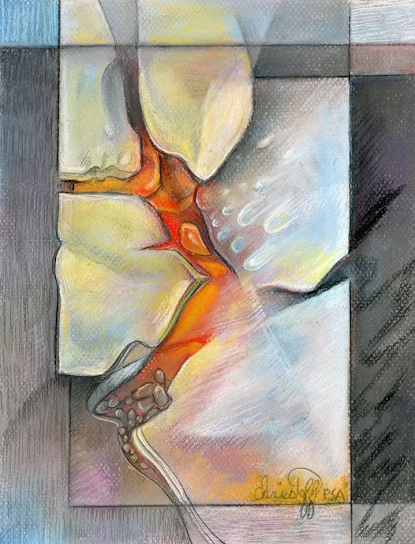 |
"Listening to Mozart" 11 x 14" Pastel
Winner of the French Canvas award at the 44th Annual Pastel Society of America Juried Exhibition
First place in pastel at the Momma Juried Art Competition, 2016
Juried into the IAPS 33rd web show, 2018
Published in "Strokes of Genious 10 2018
|
How do you know when a
painting is done?
Knowing
when a painting is done is a tricky matter.
For most artists there is no definitive way to answer this question. But
for me, I just keep adding layers until it clicks. After I feel this snapping feeling I put it
away for a few days or so, then look at it one last time. Once I decide that I am done I sign it,
photograph it and put it away until I can frame it. If I don’t put it away, I will fuss with it
forever.
Once I
was at one of those art festivals where there were not a lot of people buying
stuff. I sat at my easel for 3 days in a
row and putzed around with the same drawing.
I spent way more time on it than I normally did at that time. The last day I forgot to bring a new piece so
I just continued playing with the same drawing in hopes of getting some
attention towards my booth. Towards the
end of the last day it popped into place finally. This little drawing was the
first one that I entered into a show other than a festival. Pastel Society of America, which is an
international society for pastellists and very competitive, not only accepted
this piece but gave it an award and sold it.
I had not joined the Pastel Society of America yet but they strongly suggested that I should. They bumped
me past the first level and put me right in level two. This was the first society that I joined. Thanks
to the attention of this piece I am now a signature member of PSA! "Listening to Mozart" went on to win many other awards.The lesson
learned here for me was to take my time as much as possible and do tons of
layering until it clicks.
There
is an instructor at the art center where I work who responds quite well to this same
issue. When a student asks him if it is
done, he sits the painting across the room and asks the student to look at it
from a distance, then asks THEM if it is done yet. Usually they answer their own question. Another instructor at the center actually rings a bell when one of the students finish. I love this idea. I am thinking of buying a clown horn or something for my students.
Besides
putting some space between you and the painting by hiding it for a few days or literally looking at it across the room, what else can you do? As mentioned in a prior blog post I go for
the critique. It is nice but not helpful
at all when people say, “Oh that’s so pretty!”
I need someone to give it to me straight. I have quite a few artist friends online. We share our drawings for the rest of the
group to critique, but if this is not helpful I ask my son Eddie. He does not mince words. Often times his dad, my ex, will also
critique it upon rquest. He doesn’t worry too much
about being overly blunt, plus he is a talented artist himself. I like to have non artists critique my work
too, so my husband is often my Guinea pig.
Critiquing is so important that I like to add it to the end of every
class that I teach.
It also
helps to get a fresh perspective to give you a hint if it is done. I often look at my drawing upside down. I don’t mean that I stand on my head, I just
turn it upside down. I also take photos
of it and compare it side by side with my reference photo if I am going for the
photo realism impact. Most studios have
mirrors in them as well, since looking at your work in a mirror gives it a fresh
eye.
Artists
often get eye blind if they look at their drawings for too long so all of these
practices above can help open their eyes and answer if the drawing is done.








